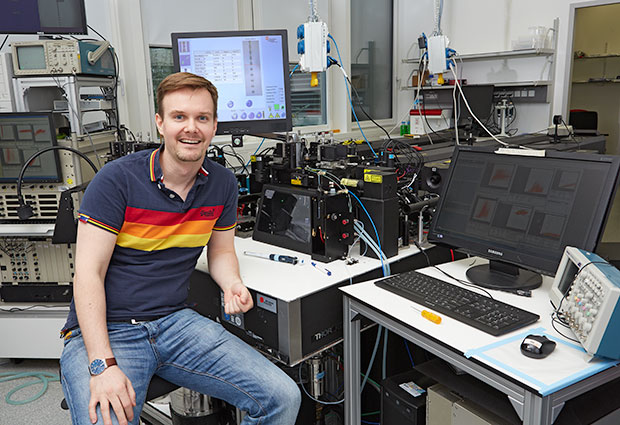
Read the latest Issue
Thanks to a mentor’s advice, Malte Paulsen has a job that’s perfectly suited to his character. As head of the Flow Cytometry Core Facility, he opens his door and promises to do everything in his power to give users a rewarding day.

The Flow Cytometry Core Facility uses powerful lasers to analyse and sort cells as they stream very rapidly past sensitive detectors. The technique’s ability to process thousands of cells in seconds enables scientists to ‘fish’ rare cells out of a sample so they can then grow colonies of those cells in a lab dish, sequence their genomes or analyse other features of interest.
There’s nothing nicer than seeing a user leave the facility happy – that’s the pay
When I was still little, my father, a chemist, used to show me and my brother small things with our children’s chemistry set. It was especially cool around New Year’s Eve when we tried to build some firecrackers on our own – that got me interested in science! Later, I admit I found pure chemistry slightly boring, so I took up biology and then biochemistry instead.
I can’t do without coffee… but as a tool: lasers and good optics. It is the mix of different lasers and very precisely matched detection optics that allow us to catch even the dimmest signal to sort samples. That ability is sometimes very important for research here at EMBL and we aim to customise our approach as much as possible to prepare the instrument optimally for each user’s assay.
Our user base is very broad. This is quite interesting here at EMBL, actually: we have users from every Unit. We do a lot of cell sorting from cell cultures of course, but we’re also seeing more and more samples coming from fish, a lot of fruit fly cells, and ‘fancier’ organisms. Flow cytometry at EMBL is not the typical flow cytometry set-up like in clinics, where you basically have your T-cells, your B-cells, your blood and maybe some lavages; here, it’s more biochemistry and cell biology. You get a lot of clone lines from genome editing – we select those out based on fluorescent markers and purify them by single-cell sorting so users can make colonies from those cells. We also have a lot of preparatory sorts, where people say ‘we need a couple of specific cells to do downstream analysis’, like sequencing. We’re usually at the start or an intermediate step for a project. Very often we’re not the last step – we have to be extremely good at our job, because there’s a lot of work that comes afterwards and a lot of work before, so we really have to be up to the task on the day.
The user has to be happy, he or she is the top priority: their project, their sample – we’ll do everything to make it possible that it runs. What really drives me is that there’s nothing nicer than seeing a user leave the facility happy – that’s actually the pay. If you know, ‘I’ve done it, they’ve got what they came for, they didn’t leave empty-handed’ – this is the best. It’s what I hope for every morning when I come to work. The same way, if something doesn’t work, I take that on board, too. It’s not like we’re not in the lab anymore: in core facilities it is quite common that we experience every user’s day.
‘Got questions? Got interesting ideas? Want to do something? Just knock and come in.’ This is what core facilities are about: we need to be approachable. If the user has an idea and doesn’t mind walking over and just knocking on the door, that’s perfect. The more they come with ideas, questions and discussions, the better. Once we know what to read up on, we can start understanding if we, with our tools, can do a task, or if we need something else or adapt our current setup to get the job done.
We have to look closely at what is hot in technology – at the moment there’s a couple of things happening, but we have to see what is really useful. And we have to see what our users need and wish for in addition to what we offer and wish for. I’ve been writing emails and meeting with users, and I’ve had nice feedback – responsiveness is really good here. EMBL is a great place to be if you have ideas that will benefit the science.
I’m now doing what I like partly because my PhD advisor Christof Niehrs – who actually did his PhD at EMBL – said ‘you know what, you’re a helpful character, why not take your skills into core facilities?’ He supported me with this and introduced me to a really good mentor, Bernhard Korn, who then showed me a lot about how core facilities work and how you should organise your core facility – I took this to heart. When I got the chance to go for a core facility, I said ‘OK, let’s give it a try,’ and from day one I was happy with that decision. It’s still my thing.
Because I love it! I really like my job, and I really love the technology – I think the mix of science and technology in flow cytometry is really cool. It’s still a very evolving field – it’s not stale. In the past few years lots and lots of things have been happening, and changing, so there are a number of things I could do here at EMBL.
Looking for past print editions of EMBLetc.? Browse our archive, going back 20 years.
EMBLetc. archive